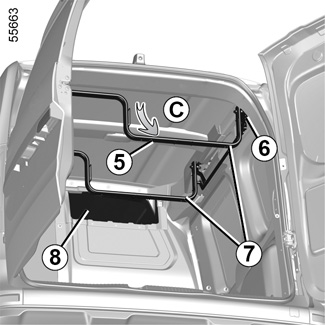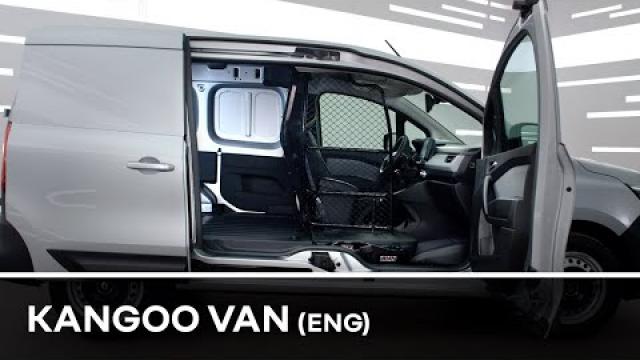TRANSPORTING OBJECTS IN THE LUGGAGE COMPARTMENT
Always position the objects transported so that the largest surface is against: | |
- the rear bench seatback, for normal loading (example A); |
|
- the front seatbacks with the rear seatbacks folded down, as is the case for maximum loads (example B); |
|
- the front seatbacks when the second and/or third-row rear seats are in the folded position or removed from the vehicle REAR SEATS: functions (example C). | |
Ensure that the objects being transported are evenly distributed throughout the loading area. If you have to place objects on the folded seat back, it is vital that you remove the headrests before folding the seat back so that it can be folded as flat as possible against the seat. | |

Heavy objects must not be transported on the rear seats when the seatbacks are folded into the table position.
Always position the heaviest items directly on the floor. Use the lashing points 1 on the boot floor, if these are fitted to the vehicle. The luggage should be loaded in such a way that no items will be thrown forward and strike the occupants if the driver has to brake suddenly. Fasten the rear seat belts, even if the seats are not occupied.


Transporting objects in the rear load area
Depending on the vehicle, rotating rings 2 and 3 can be used to prevent transported objects from moving. The number of rings and their locations may vary depending on the vehicle.
Special note for van version
Rotary rings 3:
F max : 400 daN
The sole purpose of these rings 2 is to prevent transported objects from moving. The objects must be secured to the mounting rings 3 on the vehicle floor beforehand.
For your safety, check that all the vehicle’s doors are properly closed before starting the engine.
While driving with the right rear hinged door open, always secure transported loads. The left-hand door, which remains shut, should not be used to hold transported loads in place. Using the right rear hinged door open while driving should only be done in exceptional cases.
In any event, please refer to local legislation.
Risk of loads falling on the road surface.


“Open Sesame” version
Depending on the width and length of objects carried in the rear load area, use the front passenger door and sliding side door openings.
To do this, pivot the partition 4. Please observe the procedure when pivoting the partition SWIVELLING PARTITION.


Recess 8 and roof rack 7
(depending on the vehicle)
Depending on the length of the objects being transported in the rear load area, you can use the recess 8 or the roof rack 7.
Position for use
With the roof rack in the storage position, pull the lever 6 downwards to unlock the roof rack, then hold the roof rack bar 5 and pull it towards you until it locks (movement C).
The roof rack locks automatically. Check that the bonnet is correctly locked.
Always secure the transported loads using the rings 9.
Make sure that you abide by the maximum authorised length and load weight.
Prepare any protections that may be required and adapt your driving to minimise the movement of the transported load and to avoid damaging the vehicle or the load.

Storage position
With the roof rack in the operating position, pull the handle 6 downwards to unlock the roof rack, hold the roof rack bar 5 and push it upwards until it locks (movement D).
The roof rack locks automatically. Check that the bonnet is correctly locked.
Maximum permissible load weight on roof rack 7: 30 kg evenly distributed.
Maximum load length:
- standard chassis: 2 metres;
- long chassis: 2.5 metres.
When handling the roof rack, ensure that nobody is near the moving parts.


